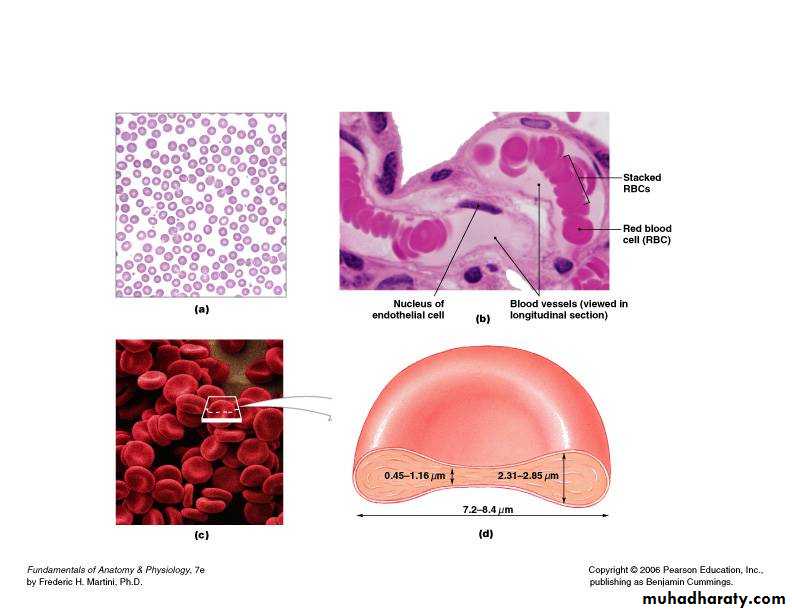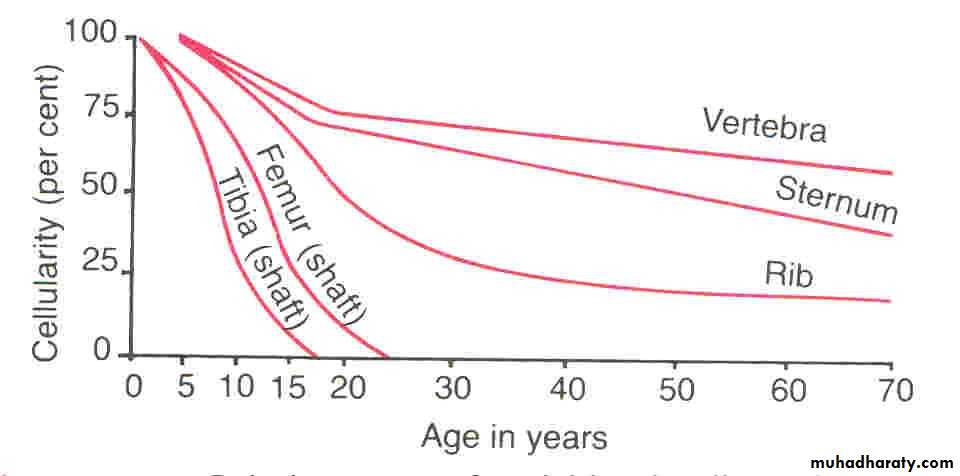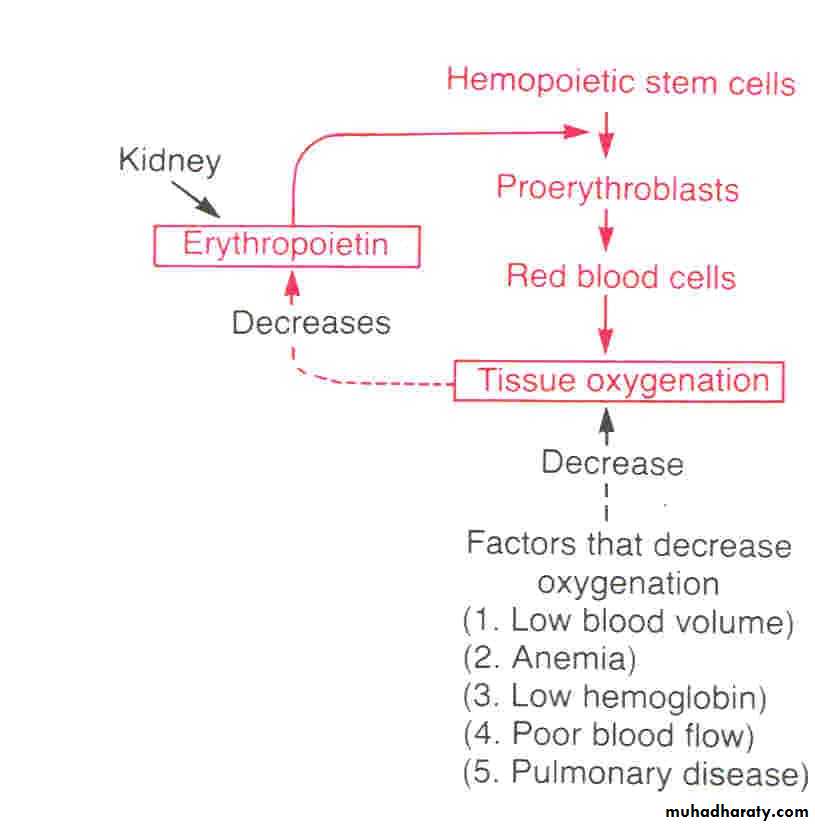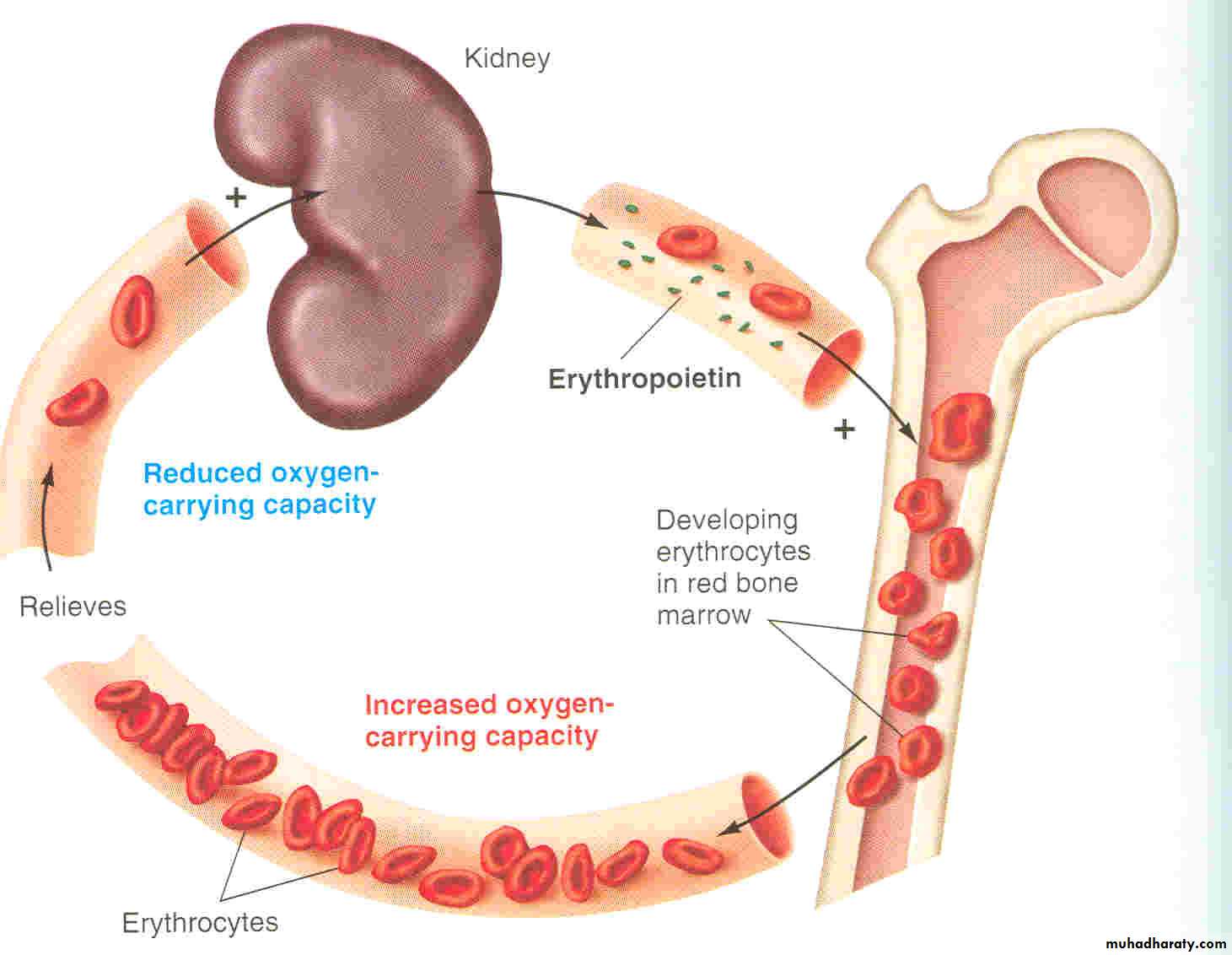بسم الله الرحمن الرحيم
Blood Physiology By Dr. Suroor MohamedMBChB. MSc, PhysiologyOBJECTIVES:
1-Describe Cellular and non-cellular components of blood2-Recognise features of blood and functions
3-Define Erythropoiesis, leucopoiesis and thrombopoiesis.
4-Recognize sites of RBC formation at different developmental age.
Blood:
It is a specialized circulating fluid connective tissue composed of cells suspended in fluid intercellular substances called plasma.It supplies O2 and nutrients & removes CO2 with waste products to all regions of the body.
Characteristics of Blood
Major Functions of Blood
• B-protection from foreign material & infections by leukocytes, antibodies& complement proteins
Cellular components:Red Blood Cells (Erythrocytes) transport O2White Blood Cells (Leucocytes) part of the immune systemPlatelets (Thrombocytes) cell fragments involved in clotting Plasma ( liquid “ non cellular” part )98% water, ions, plasma proteins (Albumin, globulin, Fibrinogen , enzymes and hormones)Same ionic composition as interstitial fluid
• 5 liter in adult45% is packed cells volume (PCV)
• 55% is plasma volume•
Plasma component
• HemopoiesisHematopoiesis the formation and development of blood cellsIn adults the cellular elements are produced in the bone marrow.Some WBCs are produced in the lymphatic tissue and bone marrow.***All blood cells formed come from a hematopoietic stem cell.Process of producing formed elements by myeloid and lymphoid stem cells Erythropoiesis: Formation of RBC (erythrocytes)Leucopoiesis: Formation of WBC (leucocytes) Thrombopoiesis: Formation of platelets (thrombocytes)In the adult, red blood cells, many white blood cells, and platelets are formed in the bone marrow. In the fetus, blood cells are also formed in the liver and spleen, and in adults such extramedullary hematopoiesis may occur in diseases in which the bone marrow becomes destroyed or fibrosed.
In children, blood cells are actively produced in the marrow cavities of all the bones. By age 20, the marrow in the cavities of the long bones, except for the upper humerus and femur, has become inactive . Active cellular marrow is called red marrow; inactive marrow that is infiltrated with fat is called yellow marrow.
Normally, 75% of the cells in the marrow belong to the white blood cell-producing myeloid series and only 25% are maturing red cells, even though there are over 500 times as many red cells in the circulation as there are white cells. This difference in the marrow reflects the fact that the average life span of white cells is short, whereas that of red cells is long.
The bone marrow contains multipotent uncommitted stem cells (pluripotential stem cells) that differentiate into one or another type of committed stem cells (progenitor cells). These in turn form the various differentiated types of blood cells. There are separate progenitor cells for megakaryocytes, lymphocytes, erythrocytes, eosinophils, basophils, neutrophils and monocytes .
The pluripotential cells are few in number but are capable of completely replacing the bone marrow when injected into a host whose own bone marrow has been completely destroyed. The best current source for these hematopoietic stem cells is umbilical cord blood.
RBCs Erythrocyte
• Most abundant cell in the blood (4 million – 6 million per microliter of blood)• Formed in the bone marrow
• Mature forms do NOT have a nucleus , mitochondria and ribosomes
• Shaped as biconcave disc (why?)
• 6-8 micrometers in diameter
***Life span of about 120 days
RBCs are narrow & flexible for excellent fluidity especially within the small capillaries
• Hemoglobin (iron protein)is found in the RBC , Hb carries oxygen from the lungs to the rest of the body and carbon dioxide binds to the RBC and is taken to the lungs to be exhaled.
• Production of RBC
• Early few weeks of embryo nucleated RBCs are formed in yolk sac.• Middle trimester mainly in liver & spleen & lymph nodes.
• Last months RBCs are formed in bone marrow of all bones
• Bone marrow of flat bone continue to produce RBC into adult life
• Shaft of long bone stop to produce RBC at puberty while epiphysis continued
• Hematopoiesis and Erythropoiesis: hematopoiesis (hemopoiesis) - the maturation, development and formation of blood cells
• A- red bone marrow (myeloid tissue) - location of hematopoiesis; mainly in axial skeleton and heads of femur & humerus
B-hemocytoblast (stem cell) - the mitotic precursor to blood cells before differentiation
• Erythropoiesis - the maturation, development, and formation of Red Blood Cells
• hemocytoblast ->proerythroblast ->early (basophilic) erythroblast ->late (polychromatophilic) erythroblast ->(hemoglobin) normoblast -> (nucleus ejected when enough hemoglobin)reticulocyte -> (retaining some endoplasmic reticulum)
ERYTHROCYTE life span:
hemocytoblast -> reticulocyte 3-5 DAYSreticulocyte -> ERYTHROCYTE 2 DAYS (in blood)
ERYTHROCYTE lifespan 100-120 Days
(primarily destroyed by macrophages in the spleen)
• Regulation of Erythropoiesis
1- Erythropoiesis is stimulated by erythropoietin hormone produced by the kidney in response to hypoxia (low oxygen in the blood)
• Hypoxia caused by:
• . Less RBCs from bleeding
• . Less RBCs from excess RBC destruction
• . Low oxygen levels (high altitude, illness)
• . Increased oxygen demand (exercise)
• . Erythropoietin
• Is Glycoprotein 90% from renal cortex 10% liver• Stimulate the growth of early stem cells
• Does not affect maturation process
• Can be measured in plasma & urine
• High levels of erythropoietin
• anemia
• -High altitude Polycythemia
• Heart failure
• Lungs disease
• B- Iron - essential for hemoglobin to carry oxygen
• 1- 65% of Fe in body is in hemoglobin
• 2-liver and spleen store most excess Fe bound to ferritin and hemosiderin
• . 3-Fe in blood bound to transferrin
• 4-daily Fe loss: 0.9 mg men/l.7 mg women
• C – Vitamins as B-complex - Vit B12 and Folic Acid essential for DNA synthesis in early mitotic divisions leading to erythrocytes














